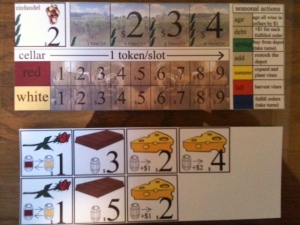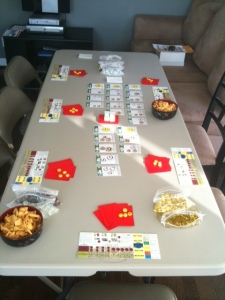 The next four iterations of Viticulture (3-6) simplified a lot of the concepts from the previous versions. Although we would return to the concept later, at the time I eliminated the worker cards that were on the table for anyone to hire. The cards were interesting, but I was starting to realize that the less text you have–especially text that has to be read by everyone around the table–the better.
The next four iterations of Viticulture (3-6) simplified a lot of the concepts from the previous versions. Although we would return to the concept later, at the time I eliminated the worker cards that were on the table for anyone to hire. The cards were interesting, but I was starting to realize that the less text you have–especially text that has to be read by everyone around the table–the better.
I reduced the nine plots of land to four plots (for version 4), and everyone started with zinfandel pre-planted to put them on an even playing ground. The entire wine order system also changed–instead of filling orders from countries, there were just general wine order cards that were shuffled and dealt onto the middle of the table at the beginning of the game. I was sticking with the idea that there was no game board. At the time I felt strongly about that idea, because I wanted the setup for the game to be as quick and easy as possible.
 A neat innovation for this version of the game were the seasonal dice. In the first two versions of Viticulture, every season one of the players would role a 6-sided die to determine the weather or economic conditions. 2 sides of the dice were bad; 2 were good; 2 were neutral. In the previous versions of the game, all of the different conditions were written on a big piece of paper in the middle of the board. But I realized that it would take up a lot less space to print those conditions on sticky paper and attach it to large dice (I used wooden cubes). Anything to reduce the daunting amount of information when you look at a game (new or old).
A neat innovation for this version of the game were the seasonal dice. In the first two versions of Viticulture, every season one of the players would role a 6-sided die to determine the weather or economic conditions. 2 sides of the dice were bad; 2 were good; 2 were neutral. In the previous versions of the game, all of the different conditions were written on a big piece of paper in the middle of the board. But I realized that it would take up a lot less space to print those conditions on sticky paper and attach it to large dice (I used wooden cubes). Anything to reduce the daunting amount of information when you look at a game (new or old).
I also mixed in some wine-themed cards with the grapes. Now, in addition to buying grapes, you could buy roses, chocolate, and cheese. These provided players instant bonuses. Unfortunately, those bonuses didn’t make any sense in real life. For example, a rose cannot change red wine into white or vice versa (in fact, there’s nothing that can make such magic happen). So while these bonuses were a good start, we would eventually move into new types of bonuses that made sense in the winemaking world.
This biggest update to this version–something that we kept for every subsequent version of the game–were the wine cards. You can see them in the second photo (in red). You can’t tell from these photos, but Alan created an incredible stacking mechanic that allowed players to grow their own special types of vines. There are 9 different types of grapes in the game, so it allowed for thousands of different combinations of grapes, letting players feel like they truly were vineyard owners creating their own unique blends of wine.
After our January 29 playtest, we were so happy with the game that we thought we were ready to move forward with a national playtest. I’ll go into how that worked out in the next edition of this blog.

